Research News
- Studying the agricultural transformation in Southeast Asia September 8, 2022
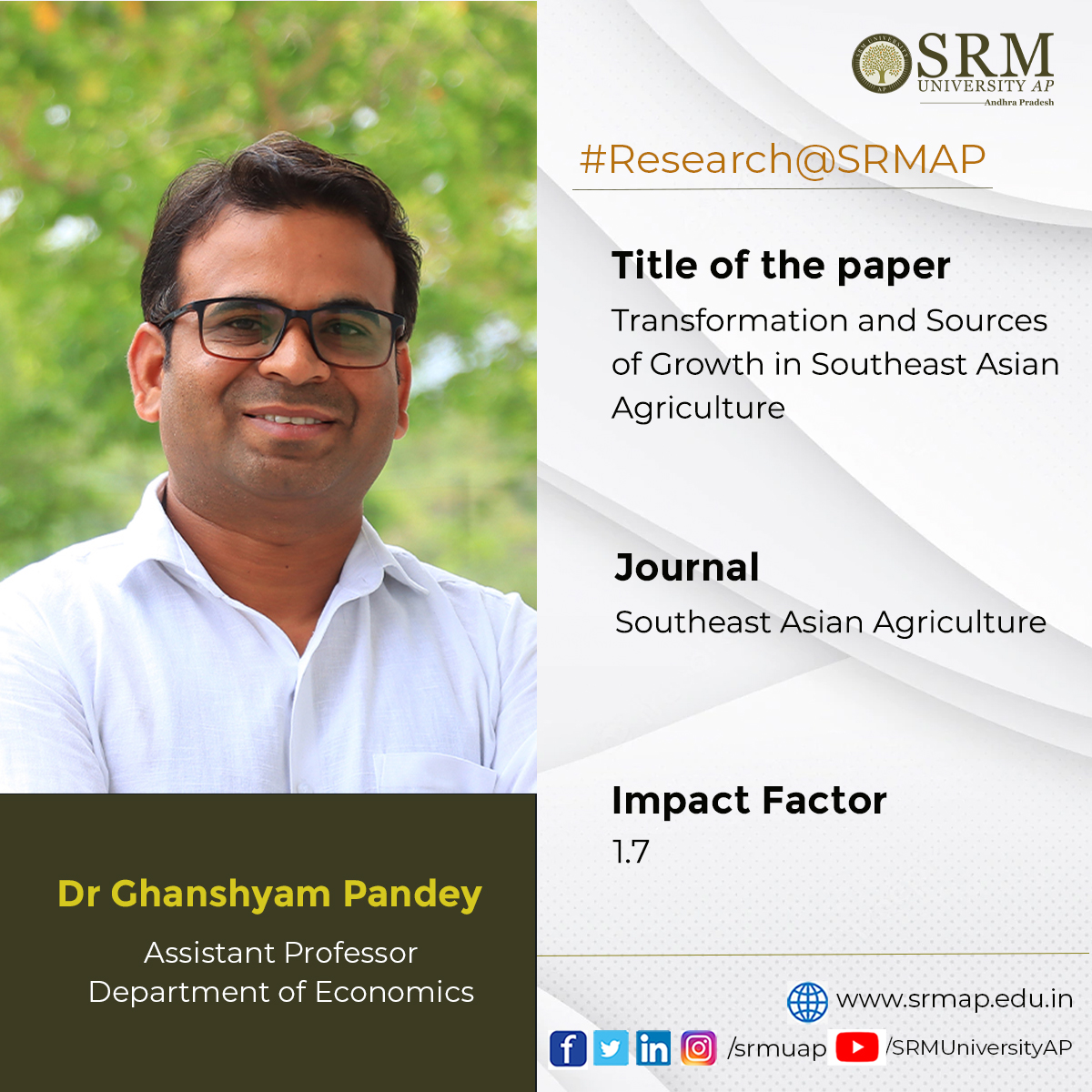
The promotion of sustainable growth of agriculture is one of the primary concerns of developing nations. The agriculture domain in Southeast Asia has undergone rapid transformation and structural changes over the last few years. Assistant Professor Dr Ghanshyam Pandey from the Department of Economics discusses the reasons for this changed scenario in his latest publication “Transformation and Sources of Growth in Southeast Asian Agriculture”. The research conducted in collaboration with International Food Policy Research (IFPRI) and the Indian Council of Agricultural Research (ICAR) was published in the Q2 journal Southeast Asian Agriculture having an Impact Factor of 1.7.
Abstract of the Research
Over the past few decades, agriculture in Southeast Asia has experienced robust growth and undergone a significant structural transformation, albeit at a different pace in different countries in the region. This paper aims to understand the agricultural transformation and growth process in Southeast Asia. The findings of this study show that driven by technological change, area expansion, and diversification, agriculture has grown faster in low-income countries in the region. In contrast, agricultural growth in high-income countries has been slow and driven by price increases, mainly of export-oriented commercial crops such as oil palm, rubber, and coconut—alongside an expansion of cropped areas under these crops. In view of the fixed supply of land and high volatility in global food prices, the area- and price-driven growth is not sustainable in the long run. For efficient, sustainable, and inclusive growth, exploiting the potential of existing and frontier technologies and diversification of production portfolios holds greater promise.
- Modified solar air heater for preserving agricultural produce September 5, 2022

There is a growing demand for decentralised systems that use renewable energy to extend the shelf life of agricultural commodities. Solar Air Heating systems (SAHs) are effective and environmentally friendly systems used to preserve agricultural produce by lowering the moisture content. Assistant Professor Dr Karthik Rajendran and his Post-Doctoral Scholar Dr VS Vigneswaran from the Department of Environmental Science have published their paper “Augmented v-corrugated absorber plate using shot-blasting for solar air heater – Energy, Exergy, Economic, and Environmental (4E) analysis” in the Q1 journal “Process Safety and Environmental Protection” having an Impact Factor of 7.9. The paper was published in collaboration with D. Sung Chul Kim, Shandong University, China.
South Asia is home to the majority of the world’s hungry people. Among 116 nations, India, the second-most populated nation in the world, is ranked 101st in the global hunger index. There is cause for concern given that India loses over 67 million tonnes of food annually, which is equivalent to about Rs. 92,000 crore. In 2016, the Indian Council of Agricultural Research estimated that during harvest, post-harvest, processing, and storage, about 4.3-6.1% of pulses, 3.9-6% of grains, 2.8-10.1% of oilseeds, 6.9-13% of vegetables, and 5.8-18.1% of fruits were lost. 16% of fruits and vegetables as well as 10% of oilseeds, pulses, and cereals were lost in India due to inadequate access to storage facilities.
Each year, these losses increase in India. In order to reduce food wastage after harvest and the amount of people going hungry in India, technologies must be developed to extend the shelf life of agricultural produce. The utilisation of land, water, energy, and the release of greenhouse gases into the atmosphere can all be decreased by reducing postharvest loss. It is necessary to develop a decentralised system that uses renewable energy to extend the shelf life of agricultural products. Given that the majority of India has abundant solar energy resources, solar crop dryers based on solar air heaters (SAH) are a practical choice for conserving agricultural output by lowering its moisture content. These technologies are appealing because they are affordable and sustainable.
The performance of SAH is determined by the absorber plate. Thus, the SAH was modified with a v-corrugated absorber plate with a shot-blasted surface, and the SAH performance was investigated experimentally. Performance parameters including the energy and exergy efficiency of the collector were determined and compared with those of the conventional SAH. The study inferred that SAH optimisation will make way for the maximisation of its efficiency.
Abstract of the Research
Need for increasing the shelf life of agricultural produce using renewable energy-based A decentralized system are significantly increasing. The solar air heating systems (SAHs) are efficient and environment friendly systems which are used for preserving agricultural produce through the reduction of moisture content. However, these systems had poor thermal efficiency and the way for increasing the efficiency are much need in the present era. This article presents the energy, exergy, and economic analysis of a modified solar air heater system (SAH). The proposed (modified) SAH has a V-corrugation absorber plate; the inner surface was modified using shot-blasting technology. This is the first study to experimentally investigate a modified SAH and compare the results with those of a conventional SAH. Additionally, an environmental and sustainability assessment of the SAH is presented. The SAH performance was tested at airflow rates ranging from 0.01 to 0.02 kg. sec.
Continue reading → - Dr Pankaj Pathak co-edited and authored in the springer publication series September 5, 2022

Dr Pankaj Pathak, Assistant Professor, Department of Environmental Science co-edited the book “Circular Economy in Municipal Solid Waste Landfilling: Biomining & Leachate Treatment: Sustainable Solid Waste Management: Waste to Wealth” in collaboration with Prof Sankar Ganesh Palani from BITS Pilani, Hyderabad. The book was released as part of the Springer publication series ‘Radionuclides and Heavy Metals in the Environment’ that covers issues pertaining to environmental pollution of air, water and soil, causative toxic agents, including radioactive materials, and remediation strategies.
The book is a ready reckoner of contemporary information regarding municipal solid waste landfill biomining, treatment of landfill leachate and heavy metals in a single platform. Construction of new landfills which requires huge monetary investments can be avoided if old landfills were bio-mined for resources and the space can be re-used as new landfills. Landfill leachate is a hazardous waste which needs proper treatment that could generate value-added products such as clean energy and biofertilizers. The book is a rich repository of information for academicians, researchers, and students at master’s and doctoral levels to understand the current trends in municipal solid waste landfill operations.
It also features the chapter, ”Valorization of Solid Waste from Landfill Activities” co-authored by Dr Pankaj Pathak and her PhD scholar MSSR Tejaswini along with Prof Sankar Ganesh Palani and Dr Prangya Ranjan Rout from Thapar Institute of Engineering and Technology. The article states that urban mining of various types of landfill wastes helps in the conservation of natural resources as well as increases the economic value of the disposed of wastes. It also ensures maximum recovery from the wastes that can be used as a secondary raw material for production purposes. Accordingly, they determine the environmental impacts associated with landfill wastes and identify different technologies that would help in the conversion of waste into resources through urban mining.
Essentially the book provides a circular economy approach to municipal solid waste (MSW) management. It also reviews the current technologies and future trends in MSW treatment by focusing on technological solutions for MSW treatment in developing countries in comparison with developed countries.
Continue reading → - Large-scale production of BP nanosheets September 1, 2022
 Research at the Department of Physics has effectively produced and characterised BP nanosheets on a large scale by a simple solvothermal approach, and the formation mechanisms are discussed. The paper, 2D-Black Phosphorus/Polyaniline Hybrids for Efficient Supercapacitor and Hydrogen Evolution Reaction Applications Check for updates, has been published by Prof Ranjit Thapa, Associate Dean of Sciences, as a corresponding author, and his PhD student, Mr Samadhan Kapse in Sustainable Energy & Fuels having an Impact Factor of 6.367.
Research at the Department of Physics has effectively produced and characterised BP nanosheets on a large scale by a simple solvothermal approach, and the formation mechanisms are discussed. The paper, 2D-Black Phosphorus/Polyaniline Hybrids for Efficient Supercapacitor and Hydrogen Evolution Reaction Applications Check for updates, has been published by Prof Ranjit Thapa, Associate Dean of Sciences, as a corresponding author, and his PhD student, Mr Samadhan Kapse in Sustainable Energy & Fuels having an Impact Factor of 6.367.Abstract
Black phosphorous (BP) is an emerging 2D material with exciting physicochemical properties with broad applicability in electronics. Stability in the ambient environment, large-scale synthesis, and volume expansion during the charge/discharge process hinder its application in energy storage. Here, we report a facile gram-scale synthesis of BP in a mild reaction condition by a simple and cost-effective wet chemical method. To overcome its degradation and sluggish electrochemical performance, an organic hybrid with polyaniline is also prepared. Further, we fabricated a flexible supercapacitor device which results in an exceptional specific capacitance of 969 mFcm-2 at a current density of 0.4 Acm-2, which displayed a high energy density of 21.5 mWhkg-1 at a power density of 231 mWkg-1 with good cycling stability of 91% after 4000 charge-discharge cycles. Similarly, the cyclic voltammetry studies of the flexible devices at various bending angles display a similar CV profile for all the bending angles, which confirms the device’s reliability for flexible applications.
Explanation of the research
BP-PANI hybrid materials were prepared by the in-situ chemical oxidation method. By this approach, the researchers got highly stable BP by an inorganic-organic linkage, and its energy storage performance was also investigated. The fabricated symmetric flexible supercapacitor device based on BP/PANI heterostructure exhibited an extraordinary specific capacitance of 969 mFcm-2 at a current density of 0.4 Acm-2. Moreover, the fabricated device showed a high energy density of 21.5 mWhkg-1 and a power density of 231 mWkg-1 with impressive cycle stability of 91% after 4000 charge-discharge cycles. This study paves the way for future research into gram-scale BP synthesis, stability via an inorganic-organic coupling, and its potential application in electrochemical energy storage devices.
Social implications of the research
With the rapid growth of portable/flexible electronics and the high demand for clean energy, supercapacitors have sparked interest due to their advantages of fast charge/discharge rates, long cycle life, and high-power density compared to conventional energy-storage devices such as dielectric capacitors and Li-ion batteries. Likewise, developing new functional materials with outstanding properties could shed light on many issues, including pollution, energy, synthesis, and cost. In recent years few graphene analogues materials have been explored, and because of their tuneable physicochemical properties, they were used in energy storage applications. Generally, black phosphorus was synthesised from polymorphs of phosphorus under vigorous reaction conditions. However, these high temperature/pressure conditions suffer from safety, toxicity, controllability, and gram-scale production.
Quantum capacitance is an efficient tool for rapidly screening materials for supercapacitor applications and therefore is the future of this research. The researchers have collaborated with Mr Namsheer K, Mr Mridula Manoj, Mr Aditya Sharma, and Dr Chandra Sekhar Rout from the Functional Materials & Devices Laboratory, Centre for Nano Material Sciences, Jain University, Bangalore, India, in this work.
Continue reading → - Efficient and selective single-atom catalysts for eNRR September 1, 2022

The Department of Physics is glad to announce that Dr Ranjit Thapa and his PhD scholar Mr Samadhan Kapse have published their research paper “Descriptors and graphical construction for in silico design of efficient and selective single-atom catalysts for eNRR” in the journal Chemical Science, having an Impact Factor of 9.969. The paper was published in collaboration with Prof Shobhana Narasimhan, Theoretical Sciences Unit and School of Advanced Materials, Jawaharlal Nehru Centre for Advanced Scientific Research, Bangalore. Chemical Science is a highly prestigious nature Index journal, which accepts only breakthrough research contributions for publication.
The Haber-Bosch process for ammonia synthesis has been described as possibly the most important scientific discovery of the twentieth century. However, it requires high temperatures and pressures and results in large energy consumption and emission of greenhouse gases. That is where electrochemical nitrogen reduction reaction (eNRR) comes into the picture. It synthesizes ammonia from nitrogen and water under mild conditions (N2 + 6H+ + 6e- → 2NH3). However, currently available eNRR catalysts need improvement in three respects: (i) the efficiency of nitrogen fixation needs to be increased, (ii) the competing hydrogen evolution reaction (HER) needs to be suppressed, and (iii) hydrogen poisoning of active sites must be avoided. Transition metals are popular eNRR catalysts; however, they tend to favour hydrogen adsorption due to the formation of strong metal d – hydrogen σ bonds, and tend to have a low affinity for N2 adsorption. Their research mitigates these problems by appropriately tuning the electronic structure by altering the environment surrounding metal atoms at the active site of single-atom catalysts (SACs). Moreover, in previous works, typically, only one criterion (usually competing HER) was used to optimize catalyst function, whereas they simultaneously optimised the catalyst function with respect to multiple criteria.
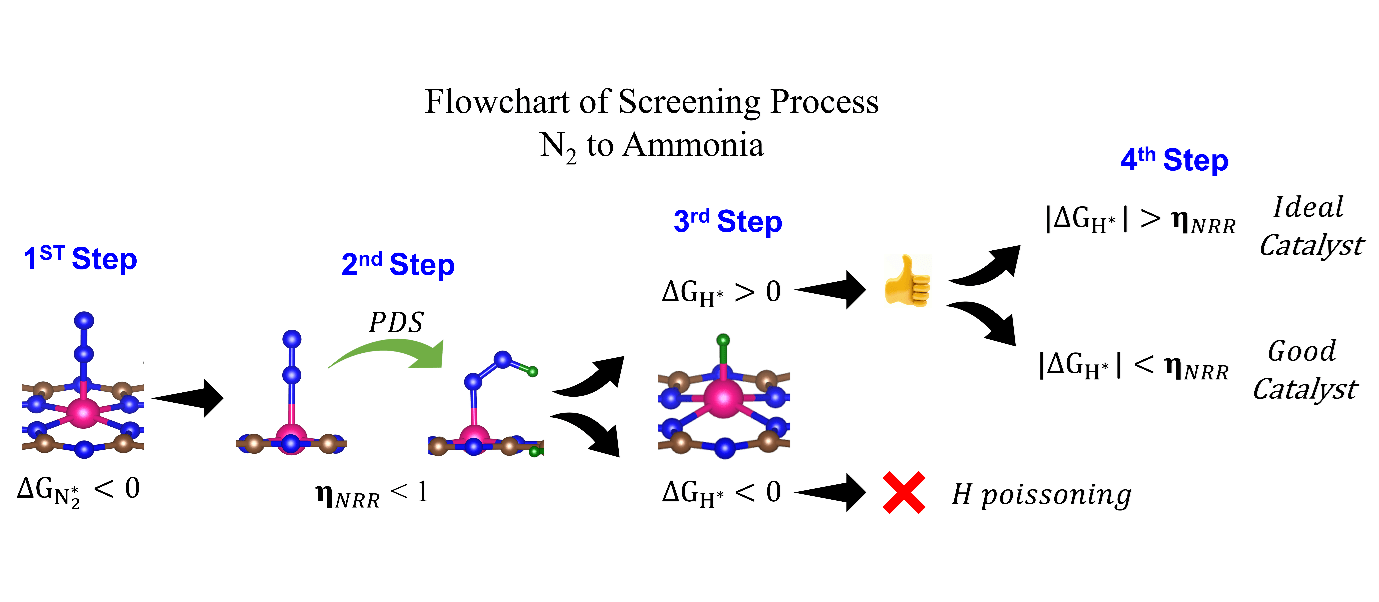
They have screened 66 different transition metal-based SACs for possible use in eNRR. To determine the best possible catalyst, they considered three factors: N2 adsorption, hydrogen poisoning and the overpotential of eNRR. Here, the valence electron occupancy (Oval) is identified as a new electronic descriptor that can predict the overpotential value. They emphasised that having a low η_NRR alone does not suffice to indicate a suitable eNRR catalyst, since if the adsorption free energy is higher for H than N2, active sites will be poisoned, hindering eNRR. Thus, they present a simple graphical procedure for identifying the most promising catalysts. To carry out this procedure, one must compute only 〖ΔG〗_(H^* ) and 〖ΔG〗_(NNH^* ), the changes in the free energies of H and NNH adsorption, respectively (note that η_NRR can be deduced if 〖ΔG〗_(NNH^* ) is known). The most promising candidate is identified as Sc-Pc, which they predict will have no H poisoning and will be highly selective for eNRR over HER. Moreover, they predict that Mn-Pc, Cr-N4, Fe-N2C2 should also be highly efficient, with low overpotential (η_NRR < 1 V) toward eNRR, and no H poisoning. In future they aim to find the selective materials for catalytic reactions by studying the origin of activity, reaction mechanism, etc.
Abstract of the Research
The electrochemical nitrogen reduction reaction (eNRR) offers the possibility of ammonia synthesis under mild conditions; however, it suffers from low yields, a competing hydrogen evolution reaction pathway, and hydrogen poisoning. We present a systematic approach toward screening single atom catalysts (SACs) for eNRR, by focusing on key parameters computed from density functional theory, and relationships between them. We illustrate this by application to 66 model catalysts of the types, TM-Pc, TM-NXCY, and TM-N3, where TM is a 3d transition metal or molybdenum. We identified the best SACs as Sc-Pc, Cr-N4, Mn-Pc, and Fe-N2C2; these show eNRR selectivity over HER and no hydrogen poisoning. The catalysts are identified through multi-parameter optimization which includes the condition of hydrogen poisoning. We propose a new electronic descriptor Oval, the valence electron occupancy of the metal center, that exhibits a volcano-type relationship with eNRR overpotential. Our multi-parameter optimization approach can be mapped onto a simple graphical construction to find the best catalyst for eNRR over HER and hydrogen poisoning.
- DST-SATHI cluster with KLU, ANU, Vignan University and AIIMS August 30, 2022
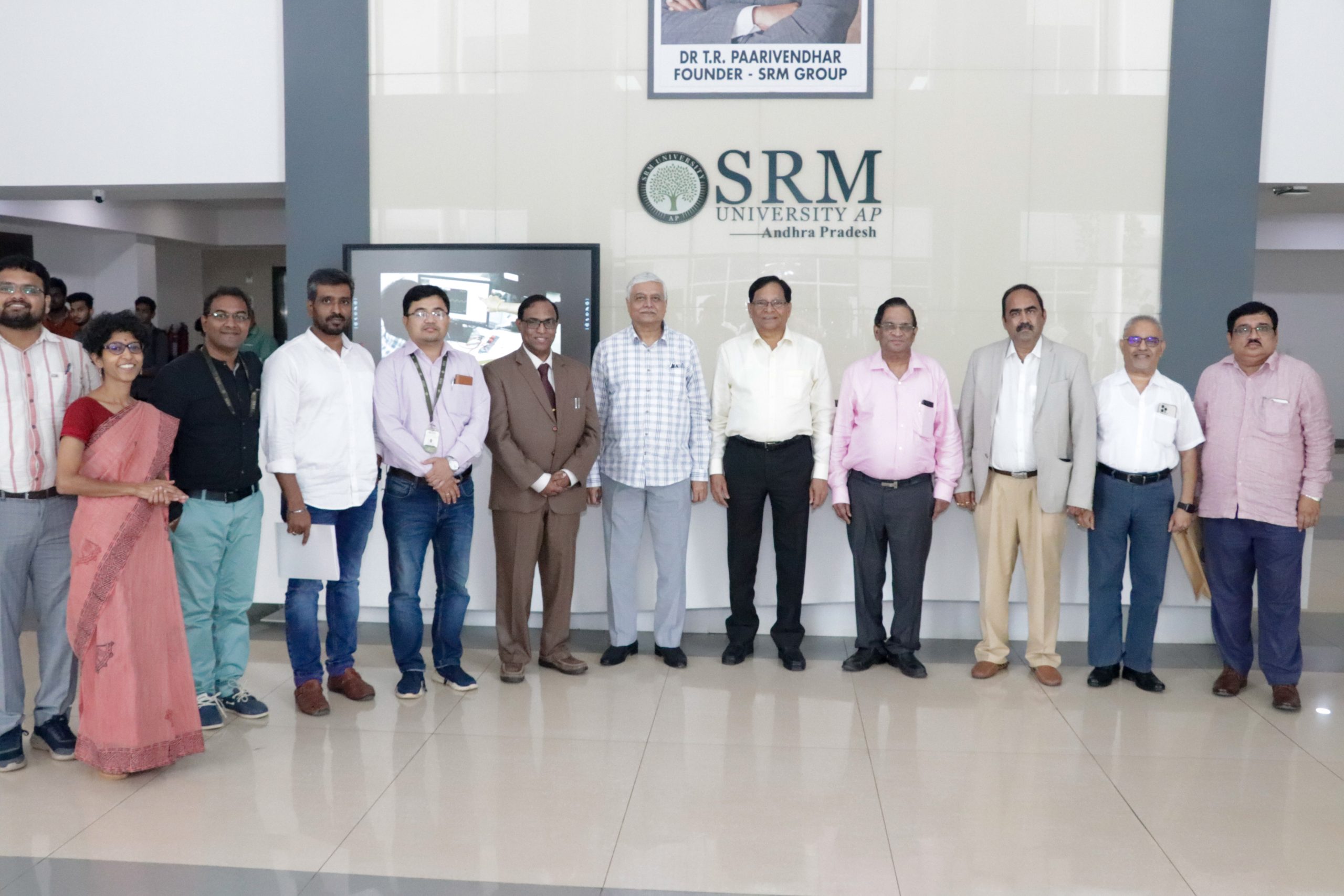 SRM University-AP formed a cluster with Acharya Nagarjuna University, KL University, Vignan University, and AIIMS Mangalagiri for the DST-SATHI initiative of the Ministry of Science and Technology. Sophisticated Analytical & Technical Help Institute (SATHI) aims to provide professionally managed services with efficiency, accessibility and transparency of the highest order under one roof to service the demands of industry, start-ups and academia. Dr P Siddaiah – Dean, Acharya Nagarjuna University; Dr Mukesh Tripathi, Director-AIIMS Mangalagiri; Dr G Pardha Saradhi Varma – Vice Chancellor, KL University; and Dr P Nagabhushan – Vice Chancellor, Vignan University; attended the meeting held at SRM University-AP campus on Monday.
SRM University-AP formed a cluster with Acharya Nagarjuna University, KL University, Vignan University, and AIIMS Mangalagiri for the DST-SATHI initiative of the Ministry of Science and Technology. Sophisticated Analytical & Technical Help Institute (SATHI) aims to provide professionally managed services with efficiency, accessibility and transparency of the highest order under one roof to service the demands of industry, start-ups and academia. Dr P Siddaiah – Dean, Acharya Nagarjuna University; Dr Mukesh Tripathi, Director-AIIMS Mangalagiri; Dr G Pardha Saradhi Varma – Vice Chancellor, KL University; and Dr P Nagabhushan – Vice Chancellor, Vignan University; attended the meeting held at SRM University-AP campus on Monday.SRM AP Vice-Chancellor Prof V S Rao invited the Vice-Chancellors of the respective universities to come forward for the formation of a cluster for the ‘SATHI’ programme. Pro-Vice Chancellor Prof D Narayana Rao did an elaborate presentation on DST projects. “The host institute, which is the lead partner in the cluster, will have to provide a functional space of 20,000 square yards, and SRM University-AP is suitable for this in every way”, Prof D Narayana Rao said. “The equipment worth Rs 75 crore to be provided through the SATHI programme will help in carrying out extensive research in all the five universities,” he added. The Vice-Chancellors and Directors of these 5 institutions have agreed to form the cluster and submit the proposal to the Department of Science & Technology (DST), Government of India. Professors of SRM AP and representatives of respective universities also attended the meeting.
Continue reading → - A multifarious study on Low-Power Wide-Area Networks August 25, 2022
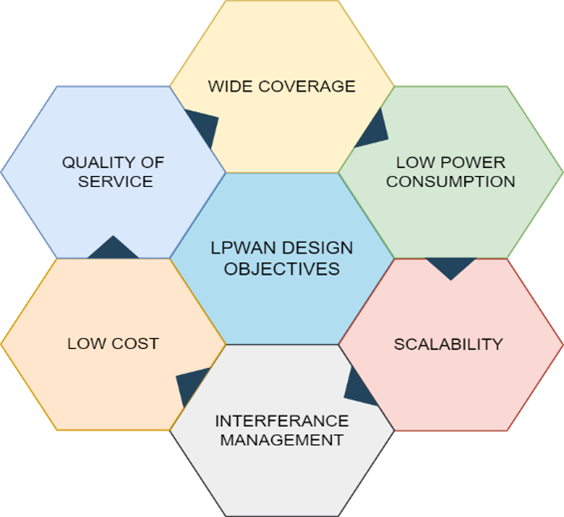
The Department of Electronics and Communication Engineering is delighted to announce that Assistant Professor Dr Anirban Ghosh and Research Scholar Mr Naga Srinivasarao Chilamkurthy have published their article titled “Low-Power Wide-Area Networks: A Broad Overview of its different aspects” in IEEE Access, a Q1 Journal, having an Impact Factor of 3.476. The work was published in collaboration with Dr Om Jee Pandey from the Indian Institute of Technology BHU, Dr Cenkeramaddi Linga Reddy from the University of Agder, and Dr Hong-Ning Dai from Hong Kong Baptist University, Hong Kong.
This is a survey article on Low-power Wide-area networks which provides a detailed description of LPWAN technologies in the context of IoT applications. In this survey article, they review and provide an overarching description of LPWAN in terms of design goals, techniques to improve design objectives, and system architecture. They have also evaluated several existing and non-standardized LPWAN technologies and the market opportunities of LPWAN. With the help of this article, the researchers can choose the best LPWAN technology for their specific applications.
The practical implementation of the article can be found in various social and commercial applications such as smart healthcare, intelligent transportation, climate-smart agriculture, rescue operations, logistics, smart cities, industries, utilities, smart buildings, consumer electronics, security, asset tracking, smart waste management systems, cognitive manufacturing, and Machine-to-Machine (M2M) communications. Their future research plans include working on Wireless Sensor Networks, Low-Power Wide-Area Networks, Small-World Networks, and applying machine learning and reinforcement learning techniques in the context of wireless networks for cyber-physical systems and IoT applications.
Abstract of the Research
Low-power wide-area networks (LPWANs) are gaining popularity in the research community due to their low power consumption, low cost, and wide geographical coverage. LPWAN technologies complement and outperform short-range and traditional cellular wireless technologies in a variety of applications, including smart city development, machine-to-machine (M2M) communications, healthcare, intelligent transportation, industrial applications, climate-smart agriculture, and asset tracking. This review paper discusses the design objectives and the methodologies used by LPWAN to provide extensive coverage for low-power devices. We also explore how the presented LPWAN architecture employs various topologies such as star and mesh. We examine many current and emerging LPWAN technologies, as well as their system architectures and standards, and evaluate their ability to meet each design objective. In addition, the possible coexistence of LPWAN with other technologies, combining the best attributes to provide an optimum solution is also explored and reported in the current overview. Following that, a comparison of various LPWAN technologies is performed, and their market opportunities are also investigated. Furthermore, an analysis of various LPWAN use cases is performed, highlighting their benefits and drawbacks. This aids in the selection of the best LPWAN technology for various applications. Before concluding the work, the open research issues, and challenges in designing LPWAN are presented.
- Dr Uma Maheswar to work on an overseas-funded project August 24, 2022
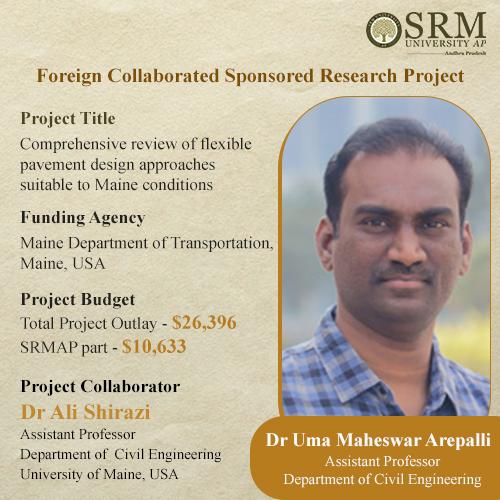
Yet another moment of pride and honour for SRM University-AP as Dr Uma Maheswar Arepalli, Assistant Professor, Department of Civil Engineering in collaboration with Dr Ali Shirazi, Assistant Professor, Department of Civil Engineering, University of Maine, USA received a research project award from the Maine Department of Transportation, Maine, USA. The project titled “Comprehensive review of flexible pavement design approaches suitable to Maine conditions” received a total project outlay of $26,396 (Rs. 21.12 Lakhs).
This is the first of its kind project in India that receives funding directly from the foreign (United States) entity unlike the typical Department of Science & Technology (DST) International Bilateral Joint Project Schemes. This 8-month-long project will review the various existing flexible pavement design approaches in the USA and will provide recommendations to the Department of Transportation on a suitable design approach conducive to the conditions of Maine.
The outcome of the project will help the Department of Transportation to decide on a suitable pavement design approach that enhances the performance of pavements in Maine. The project engenders an opportunity for two under-graduate students of SRM University-AP to work as paid interns and receive international exposure in their prospective research areas. It also involves the scope for industry translatory research.
Continue reading → - VS2-BP hybrid electrode material for supercapacitor applications August 24, 2022
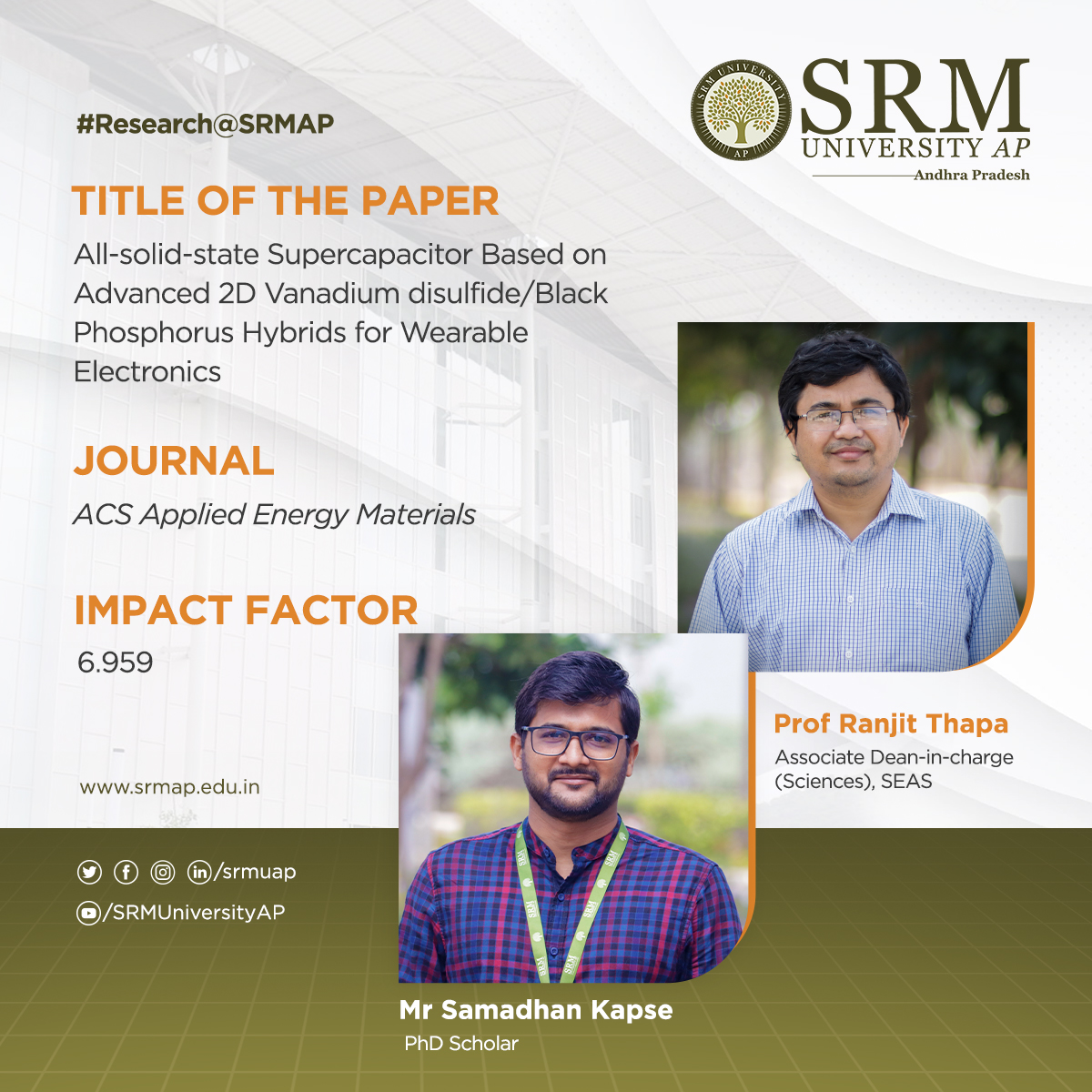 A theoretical investigation is highly important to investigate the properties of materials, the origin of selectivity, and the effect of various parameters in designing promising electrode materials for supercapacitor applications. The latest research paper by Mr Samadhan Kapse, PhD Student in the Department of Physics, and Prof Ranjit Thapa, Associate Dean of SEAMS (Sciences), envisions this and developed a novel VS2-BP hybrid electrode material. Their article titled All-solid-state Supercapacitor Based on Advanced 2D Vanadium disulfide/Black Phosphorus Hybrids for Wearable Electronics has been published in the journal ACS Applied Energy Materials with an impact factor of 6.959.
A theoretical investigation is highly important to investigate the properties of materials, the origin of selectivity, and the effect of various parameters in designing promising electrode materials for supercapacitor applications. The latest research paper by Mr Samadhan Kapse, PhD Student in the Department of Physics, and Prof Ranjit Thapa, Associate Dean of SEAMS (Sciences), envisions this and developed a novel VS2-BP hybrid electrode material. Their article titled All-solid-state Supercapacitor Based on Advanced 2D Vanadium disulfide/Black Phosphorus Hybrids for Wearable Electronics has been published in the journal ACS Applied Energy Materials with an impact factor of 6.959.Abstract
Vanadium disulfide-Black Phosphorus (VS2-BP) hybrids were synthesised by a one-pot hydrothermal assisted method to achieve enhanced electrochemical activity for supercapacitor applications. The concentration of BP was optimised to prevent the restacking nature of VS2 and to enrich the active edges for electrolytic ion intercalation. The charge storage kinetics of the best-performing VS2-BP as an active electrode has demonstrated the dominance of the pseudocapacitive nature of the material. Further, by sandwiching with PVA/K2SO4 gel electrolyte, an all-solid-state (ASS) Vanadium disulfide/Black Phosphorus-50 mg (VS2-BP-50) symmetric device was developed on highly conductive carbon paper. The ASS VS2-BP-50 symmetric device displays the highest specific areal capacitance of 203.25 mF/cm2. It exhibits the maximum areal energy density of 28.22 µW h cm-2 at an areal power density of 596.09 mW cm-2, outperforming previous literature. We used density functional theory to understand the origin of high quantum capacitance. We found that the charge accumulation region between VS2 and BP monolayers and the charge transfer is the origin of the improved density of states in the VS2-BP hybrid. Also, we observed the higher mobility of K+ ion and a higher diffusion rate using the Density functional theory (DFT) method.
Explanation of the research
A novel VS2-BP hybrid electrode material was prepared using a simple hydrothermal approach. Due to a synergistic effect, it was discovered that adding BP to metallic VS2 enhances the number of electrochemically active sites, resulting in increased surface activity. It also accelerates reaction kinetics with electrolyte ions by improving the electrical behaviour of active electrode material. As a result, the hybrid technique overcomes the weaknesses of individual components during electrochemical processes, resulting in increased performance that has been limited by individuals. The BP nanosheets behaved as a pore region for electron transport and prevented the VS2 layers from re-stacking. Systematic experiments are conducted by selecting the ideal precursor ratios to generate a high-quality VS2-BP hybrid with enhanced electronic conductivity. Furthermore, in the overall collective charge storage of the VS2-BP-50 hybrid material, the present results demonstrated that capacitive contributions outnumber diffusive contributions. The ASS VS2-BP-50 symmetric supercapacitor device was also designed to have a high areal capacitance of 203.25 mF/cm2 with a maximum areal power density of 596.09 mW cm-2. The extraordinary performance of the ASS VS2-BP-50 symmetric device illustrates its versatility in terms of designing a high-power density ASS supercapacitor for flexible and wearable device applications. The work functions of BP, VS2, and VS2-BP are 0.73 eV, 5.37 eV, and 4.99 eV, respectively, which help in the charge transfer mechanism and increase the density of state at the Fermi level, and subsequently, the quantum capacitance of the heterostructure.
Collaborations
1. Mr Aditya Sharma, Centre for Nano and Material Sciences, Jain Global Campus, Jakkasandra, Ramanagaram, Bangalore – 562112, Karnataka, India
2. Mr Ankur, Centre for Nano and Material Sciences, Jain Global Campus, Jakkasandra, Ramanagaram, Bangalore – 562112, Karnataka, India
3. Mr Sagar Bisoyi, Department of Physics, School of Applied Sciences, KIIT Deemed to be University, Bhubaneswar-751024, Odisha, India.
4. Dr Gopal K. Pradhan, Department of Physics, School of Applied Sciences, KIIT Deemed to be University, Bhubaneswar-751024, Odisha, India.
5. Dr Chandra Sekhar Rout, Centre for Nano and Material Sciences, Jain Global Campus, Jakkasandra, Ramanagaram, Bangalore – 562112, Karnataka, India
Social implications of the research
With the exponential development of portable/flexible electronics and the high demand for renewable energy, conventional energy-storage devices, such as supercapacitors, have attracted attention due to their benefits of fast charge/discharge rates, long cycle life, and high-power density. Similarly, developing novel functional materials with exceptional qualities could shed light on a plethora of challenges, including environmental pollution, energy crisis, etc. Two-dimensional (2D) layered materials, such as metallic 1T MoS2 single layers, SnSe2, MXenes, and black phosphorous (BP), have been intensively studied for supercapacitor applications. These materials benefit from efficient ion intercalation and electrosorption. The two-dimensional (2D) layered transition-metal dichalcogenides (TMDs) have recently piqued the scientific community’s curiosity.
- Patient’s E Healthcare Records Management System August 23, 2022
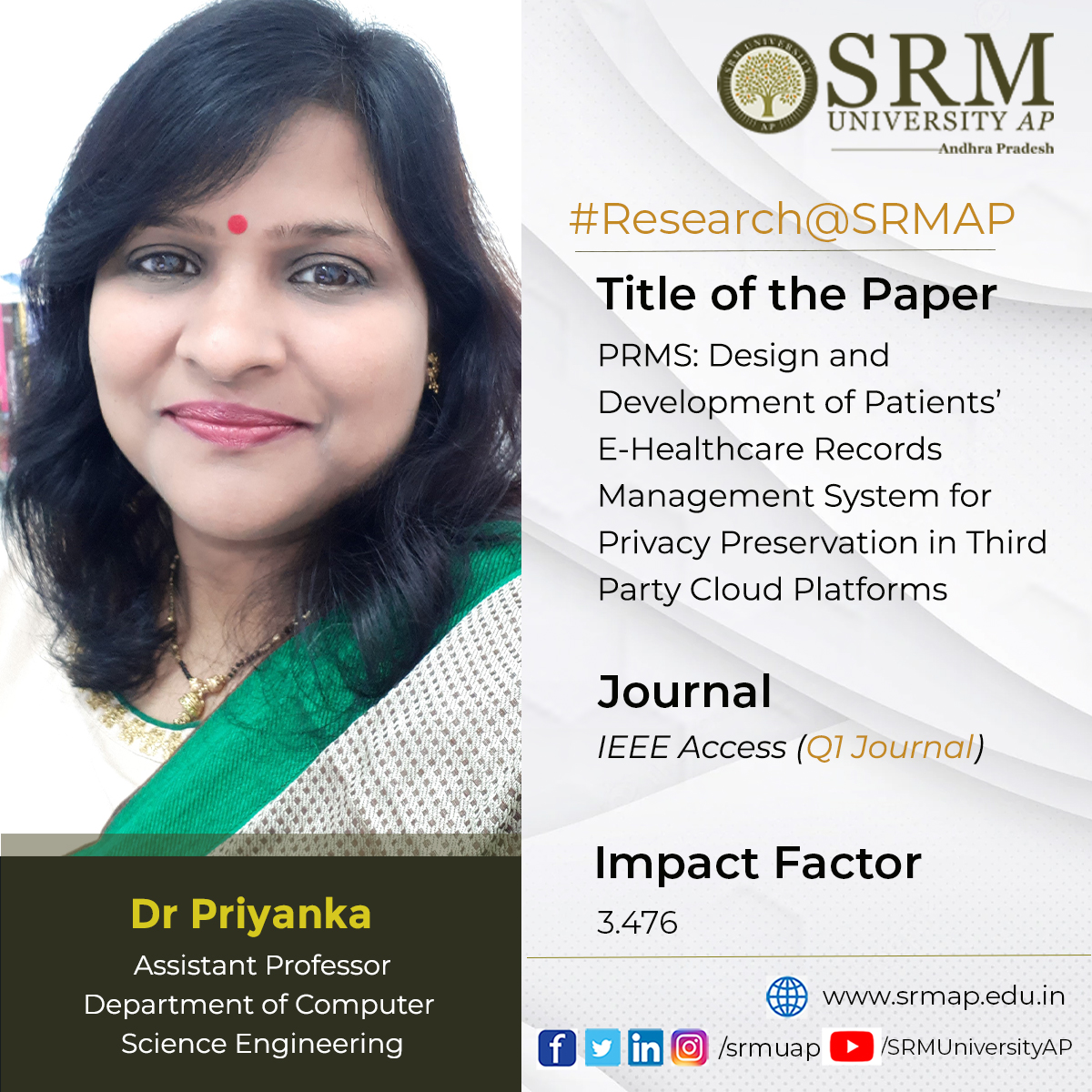 Publishing papers in Q1 journals is a remarkable accomplishment for research enthusiasts. Assistant Professor Dr Priyanka of the Department of Computer Science and Engineering published her latest research paper in the IEEE Access journal. The paper titled PRMS: Design and Development of Patients’ E-Healthcare Records Management System for Privacy Preservation in Third Party Cloud Platforms has an impact factor of 3.476. Kirtirajsinh Zala, Hiren Kumar Thakkar, Rajendrasinh Jadeja, Priyanka Singh, Ketan Kotecha, and Madhu Shukla co-authored the work with Dr Priyanka.
Publishing papers in Q1 journals is a remarkable accomplishment for research enthusiasts. Assistant Professor Dr Priyanka of the Department of Computer Science and Engineering published her latest research paper in the IEEE Access journal. The paper titled PRMS: Design and Development of Patients’ E-Healthcare Records Management System for Privacy Preservation in Third Party Cloud Platforms has an impact factor of 3.476. Kirtirajsinh Zala, Hiren Kumar Thakkar, Rajendrasinh Jadeja, Priyanka Singh, Ketan Kotecha, and Madhu Shukla co-authored the work with Dr Priyanka.Abstract
In the digital era, personal data storage on public platforms is a significant cause of concern with severe security and privacy ramifications. This is true especially in e-health data management since patients’ health data must be managed following a slew of established standards. The Cloud Service Providers (CSPs) primarily provide computing and storage resources. However, data security in the cloud is still a major concern. To overcome e-healthcare records privacy issues in a third-party cloud, we designed a Patient’s E Healthcare Records Management System (PRMS) that focuses on latency and throughput. Moreover, the proposed PRMS system is compared with Blockchain platforms such as Hyperledger Fabric v0.6 and Etherium 1.5.8 against latency and throughput by adjusting the workload for each platform up to 10,000 transactions per second. The proposed PRMS is compared to the Secure and Robust Healthcare Based Blockchain (SRHB) approach using Yahoo Cloud Serving Benchmark (YCSB) and small bank datasets. The experimental results indicate that deploying PRMS on Amazon Web Services decreases System Execution Time (SET) and the Average Delay (AD) time by 2.4%, 8.33%, and 25.15%, 15.26%, respectively. Deploying PRMS on the Google Cloud Platform decreases System Execution Time (SET) and Average Delay (AD) by 2.27%, 2.4%, and 2.72%, 4.73% AD, respectively.
Continue reading →

